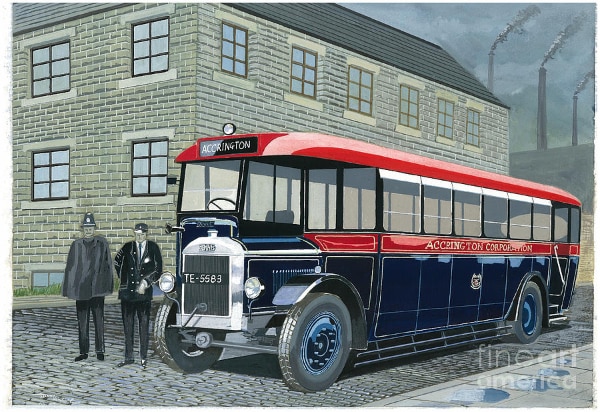
From 1928 onwards, Accrington Corporation buses were strikingly painted in red and blue. In books, newspaper articles and websites, the story is repeatedly told that the colour scheme is that of the East Lancashire Regiment, and commemorates the Accrington Pals1 Yet the story seems to have no foundation in fact.  Above: Springtime in Accrington, a painting by John Kinsley. Reproduced with kind permission of the artist. Although a number of colour combinations have been associated with the East Lancashire Regiment and its predecessors, the 30th and 59th Regiments, a red and blue scheme seems not to have been among them. The 30th Regiment favoured red and white, while their sportsmen wore maroon, black and primrose, a combination which was adopted by the East Lancashires.2 If the lack of evidence of a regimental association with the red and blue colour scheme were not enough, then the complete absence of any connection to the East Lancashire Regiment in newspaper reports contemporary with its first appearance surely settles the question. Reporting on the inaugural bus service scheduled for 12th November 1928, the Accrington Observer & Times went no further than to give a detailed description of the new livery: Both externally and internally the buses have a very pleasing appearance. The colour scheme is quite different from that on the majority of services on the road. The main panels on the exterior are in royal blue, with a gold lining, and the borough coat of arms forming a prominent decoration in the centre. The waist panel is in red, also relieved with a gold lining, and the words "Accrington Corporation" conspicuously displayed. The roof, window panes, and all the mouldings are in black, edged in fine white lines.3 Update (December 2020): an appeal for funding to restore a 1975 Leyland Leopard bus (from #AmazingAccrington, accessed 12th December 2020) includes the suggestion that the red and blue colour scheme of the Accrington Corporation buses was adopted from the "dress colours of the Accrington Pals Battalion when it was formed", despite it being "unpopular with the troops". This seems hardly credible given the unpopularity of the 'Kitchener blue' serge uniform and would surely have been remarked upon in the aforementioned newspaper report.
© Andrew C Jackson 2020
|